标签:数据分析 show 数据保存 查看 SQ exist tail sts sele
1. 将新闻的正文内容保存到文本文件。
def writeNewsDetail(content): f=open(‘gzccnews.txt‘,‘a‘,encoding=‘utf-8‘) f.write(content) f.close()
content=soupd.select(‘.show-content‘)[0].text.strip() writeNewsDetail(content)
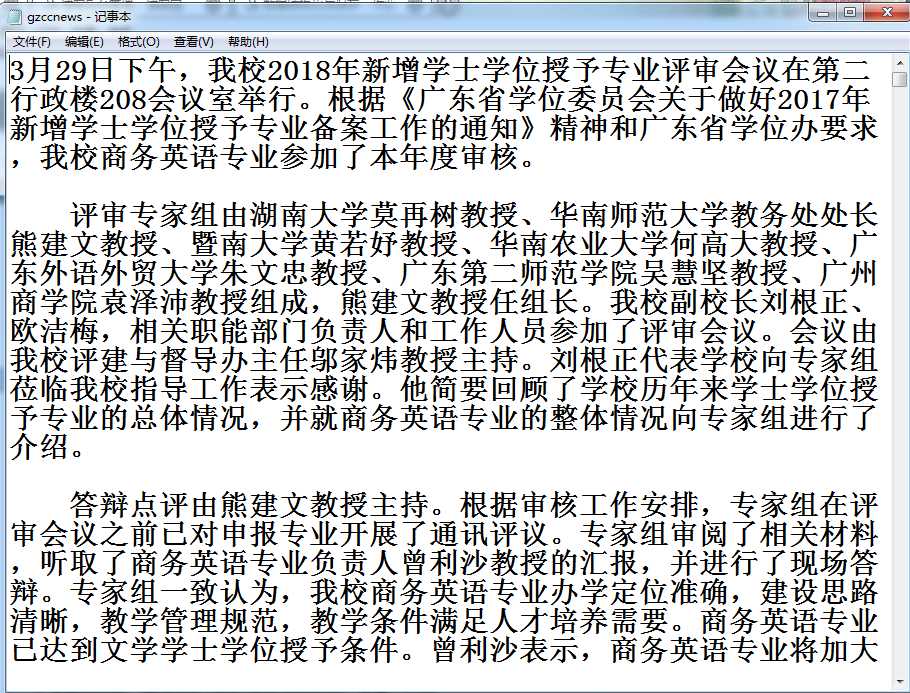
2. 将新闻数据结构化为字典的列表:
单条新闻的详情-->字典news
def getNewsDetail(newsUrl): resd = requests.get(newsUrl) resd.encoding = ‘utf-8‘ soupd = BeautifulSoup(resd.text, ‘html.parser‘) news={} news[‘title‘]=soupd.select(‘.show-title‘)[0].text info=soupd.select(‘.show-info‘)[0].text news[‘ti‘]=datetime.strptime(info.lstrip(‘发布时间:‘)[0:19], ‘%Y-%m-%d %H:%M:%S‘) if info.find(‘来源:‘)>0: news[‘source‘]=info[info.find(‘来源:‘):].split()[0].lstrip(‘来源:‘) else: news[‘source‘]=‘none‘ news[‘content‘]=soupd.select(‘.show-content‘)[0].text.strip() news[‘click‘]=getClickCount(newsUrl) news[‘newsUrl‘]=newsUrl # content=soupd.select(‘.show-content‘)[0].text.strip() # writeNewsDetail(content) print(news) return (news)

一个列表页所有单条新闻汇总-->列表newsls.append(news)
def getListPage(pageUrl): # 9. 取出一个新闻列表页的全部新闻 包装成函数def getListPage(pageUrl) res = requests.get(pageUrl) res.encoding = ‘utf-8‘ soup = BeautifulSoup(res.text, ‘html.parser‘) newslist=[] for news in soup.select(‘li‘): if len(news.select(‘.news-list-title‘)) > 0: g = news.select(‘a‘)[0].attrs[‘href‘] # print(g) newslist.append(getNewsDetail(g)) print(newslist) return (newslist)

所有列表页的所有新闻汇总列表newstotal.extend(newsls)
newstotal=[] pageUrl=‘http://news.gzcc.cn/html/xiaoyuanxinwen/‘ n=getPageN() for i in range(n-1,n): # print(i) listPageUrl=‘http://news.gzcc.cn/html/xiaoyuanxinwen/{}.html‘.format(i) # print(listPageUrl) newstotal.extend(getListPage(listPageUrl)) # print(newstotal)

3. 安装pandas,用pandas.DataFrame(newstotal),创建一个DataFrame对象df.
4. 通过df将提取的数据保存到csv或excel 文件。
df=pandas.DataFrame(newstotal) df.to_excel(‘gzccs.xlsx‘,encoding=‘utf-8‘) print(df)
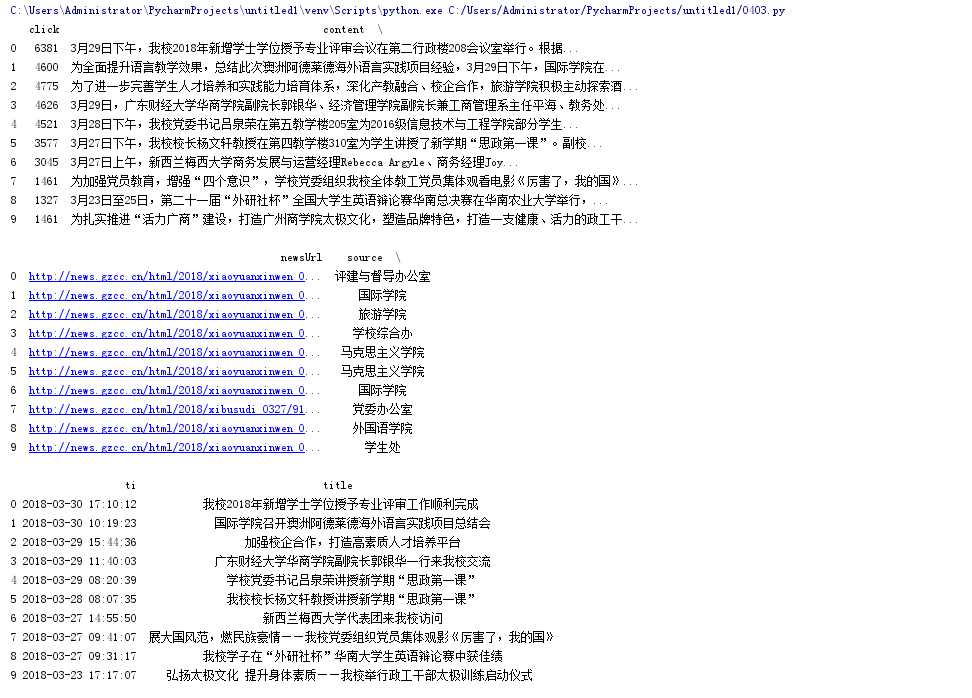

5. 用pandas提供的函数和方法进行数据分析:
提取包含点击次数、标题、来源的前6行数据
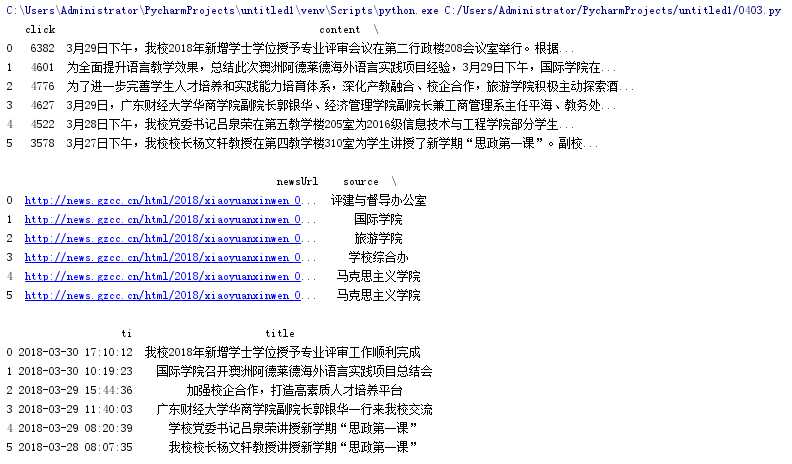
提取‘学校综合办’发布的,‘点击次数’超过3000的新闻。
print(df[df[‘click‘]>3000])
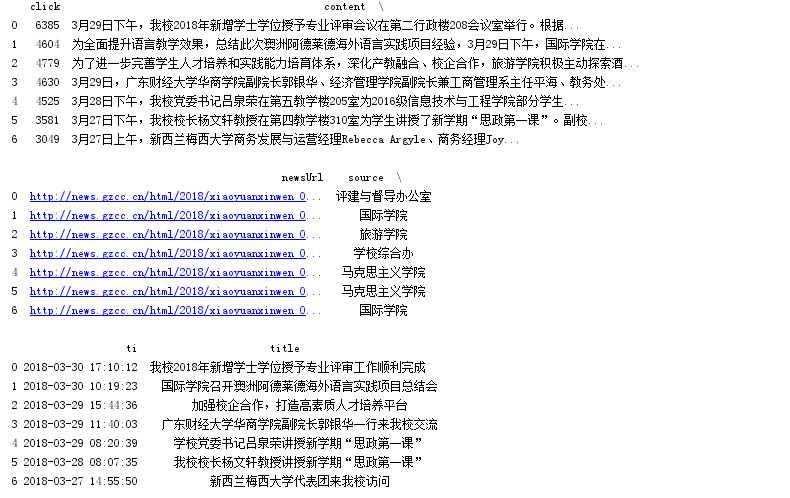
提取‘国际学院‘和‘学生工作处‘发布的新闻。
sou=[‘国际学院‘,‘学生处‘] print(df[df[‘source‘].isin(sou)])
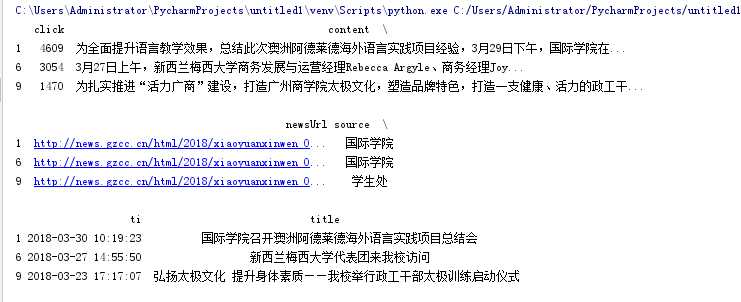
进取2018年3月的新闻
df1=df.set_index(‘ti‘) d=df1[‘2018-03‘]
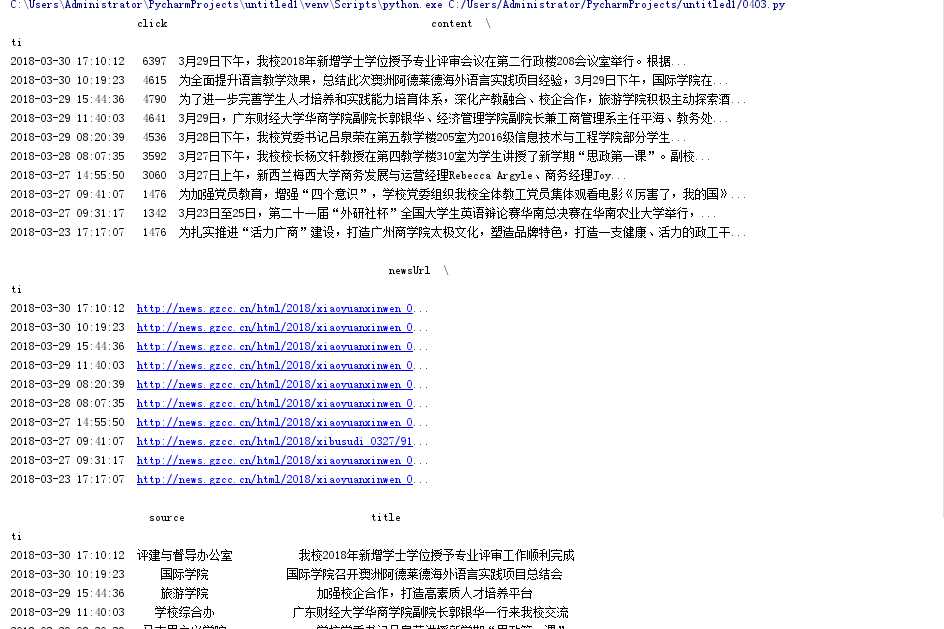
6. 保存到sqlite3数据库
import sqlite3
with sqlite3.connect(‘gzccnewsdb.sqlite‘) as db:
df3.to_sql(‘gzccnews05‘,con = db, if_exists=‘replace‘)
df1=df.set_index(‘ti‘) re=df1[‘2018-03-30 10:19:23 ‘:‘2018-03-29 08:20:39 ‘] import sqlite3 with sqlite3.connect(‘gzccnewsdb.sqlite‘) as db: re.to_sql(‘gzccnews05‘,con = db, if_exists=‘replace‘)
7. 从sqlite3读数据
with sqlite3.connect(‘gzccnewsdb.sqlite‘) as db:
df2 = pandas.read_sql_query(‘SELECT * FROM gzccnews05‘,con=db)
print(df2)
with sqlite3.connect(‘gzccnewsdb.sqlite‘) as db: df2 = pandas.read_sql_query(‘SELECT * FROM gzccnews05‘, con=db) print(df2)
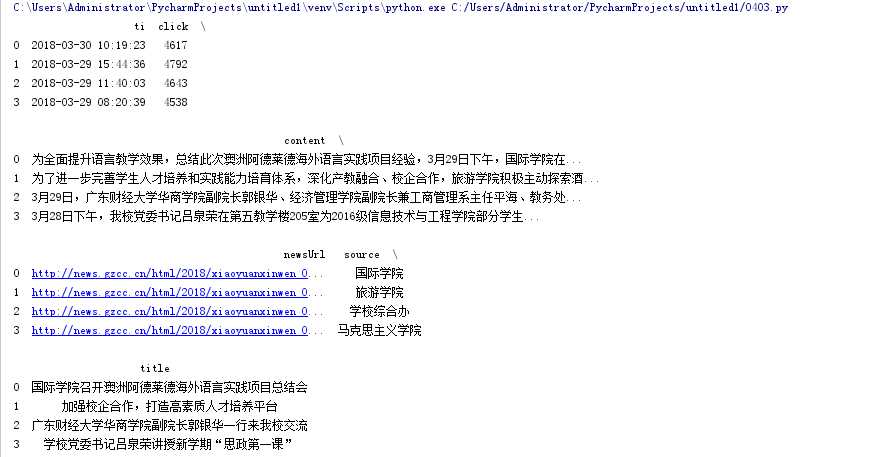
8. df保存到mysql数据库
安装SQLALchemy
安装PyMySQL
MySQL里创建数据库:create database gzccnews charset utf8;
import pymysql
from sqlalchemy import create_engine
conn = create_engine(‘mysql+pymysql://root:root@localhost:3306/gzccnews?charset=utf8‘)
pandas.io.sql.to_sql(df, ‘gzccnews‘, con=conn, if_exists=‘replace‘)
MySQL里查看已保存了数据。(通过MySQL Client或Navicate。)
from sqlalchemy import create_engine conn=create_engine(‘mysql+pymysql://root:mysql@localhost:3306/gzccnews?charset=utf8‘) pandas.io.sql.to_sql(df,‘gzccnews‘,con=conn,if_exists=‘replace‘)
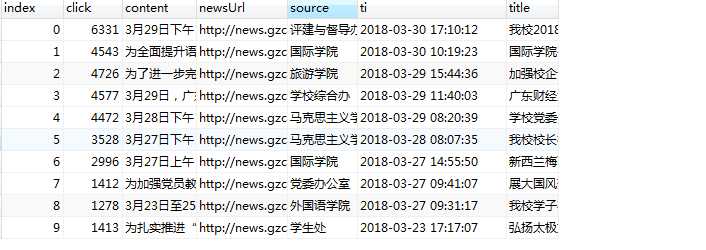
标签:数据分析 show 数据保存 查看 SQ exist tail sts sele
原文地址:https://www.cnblogs.com/cgz123/p/8869734.html